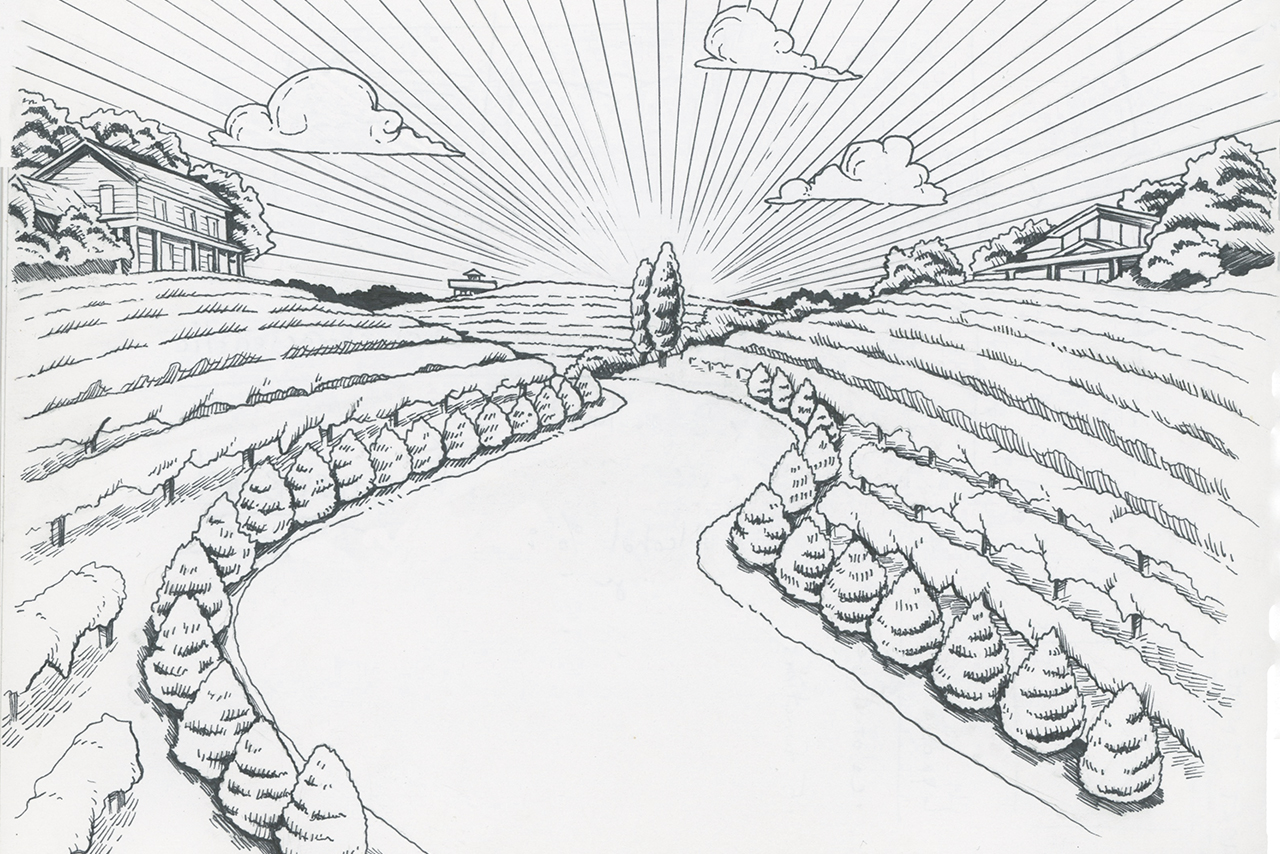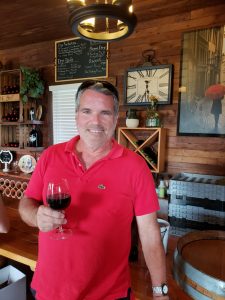It made no sense to Peter Foreman that wineries would partner with their rivals, sending customers down the road, crowding onto the same website, and planning wine and cheese events together. Foreman, an associate professor in Illinois State University’s College of Business, hadn’t even heard of wine trails when a Missouri colleague called in 2012 to pitch the idea of studying them.
“I like wine, but I’d never been on a wine trail, or if I had, I didn’t know it,” Foreman said.
Wine trails are essentially an association of regional wineries working together in a rising-tide-lifts-all-boats kind of way. Vineyards began forming trails in the 1970s in the Northeast United States—predating European trails by about 30 years—and the phenomena later spread to the Midwest.
Appears InWine trails are an example of “collective entrepreneurship,” Foreman said, and that interested him because of his research on organizational identity. He partnered with Randall Westgren, a professor of agricultural and applied economics at the University of Missouri, to find out what makes a successful wine trail, whether there are general requirements, how they are led and governed, and why some trails become popular while others struggle or disband.
The state of Missouri funded a study of the Hermann Wine Trail. It is one of 10 Missouri trails, comprising seven wineries connected by strong German roots. The trail has a strong cultural identity and was one of the most restrictive wine trails Foreman and Westgren researched. Member wineries are required to grow all their grapes and to serve only wine made on their estate.
The Missouri research became the seed for a three-year, $500,000 U.S. Department of Agriculture (USDA) grant awarded to the pair to study group entrepreneurship and collective action in the wine industry. The research project began in 2014 and expanded to wine trails in New York.
“We wanted to identify the best practices that allowed this collective entrepreneurship,” Foreman said. “How do you get organizations to cooperate and how do you get them to cooperate when they really are head-to-head competitors?”
Although the agricultural sector has a long history of cooperatives, they are typically formal, taxable entities with shareholders. Wine trails are voluntary organizations that do not have their own tax status, Westgren said. “They are affiliates of people trying to achieve their goals through group or collective action without having the millstone of corporate structure hanging on them.”
Foreman conducted 47 formal interviews with wine trail members and key stakeholders in New York, and 17 in Missouri. He also surveyed 130 trail members and customers, visited member vineyards, and analyzed brochures and websites. Asking members about their perceptions of the trail, its structure, policies, and procedures, he also wanted to know how conflict was handled, and what contributed to winemakers’ perceptions of legitimacy and satisfaction.
Foreman found that the most successful trails had strong governance practices and procedures, quality leadership, and an elected board with a high degree of commitment. Trail members also had a strong sense of shared identity and actively referred customers to trail members. Winery owners typically knew and trusted each other, making them willing to cooperate and construct a common marketing plan to improve their chances for success.
The USDA cares about this research because it can provide a blueprint for successful collective ventures, said Peter Hofherr, former director of the Missouri Department of Agriculture and chief executive officer of Missouri’s largest winery, St. James Winery and Public House Brewing Co.

“A wine trail really is a group of owners who compete against each other, but who come together and form a new brand,” he said. “There are dynamics within the group, and reasons why some groups stay together and others blow up. There are certain sections in agriculture that have more trouble forming entrepreneurial ventures. This research helps inform entrepreneurial ventures in rural America.”
Hofherr wrote his dissertation at the University of Missouri on collective entrepreneurship, and he worked with Foreman and Westgren in developing the Missouri study. Not only was he viewing wine trails through the lens of public policy and rural development, he grew up on a family vineyard. His parents started the St. James winery in 1970, when there were only 300 wineries in the country. Now there are over 10,000, he said.
Foreman and Westgren’s Missouri research has already made a difference in public policy in that state, Hofherr said. The Missouri Wine and Grape Board, which furthers the growth and economic development of the grape growing industry there, took notice and is investing in trails as part of regional tourism efforts.
“If you’re on a wine trail, you’re in the tourism business whether you want to be or not,” Foreman said. “If you’re going to be a rural farm winery and you don’t want tourists, all your product is going to have to be sold off-premise and for all but the most well-known wineries that’s just not possible. If you’re a small family owned winery, you need people to come to you.”
The three most successful trails Foreman studied, as measured by longevity and profitability, were Seneca Lake Wine Trail in the heart of New York’s Finger Lakes region, Hermann in Missouri, and the Lake Erie Wine Trail, which runs through Pennsylvania and New York.
That sense of neighbors helping neighbors, which runs deep in agriculture, was a common thread in the most successful trails, Foreman said. When he suggested to the owner of Stone Hill Winery in Hermann that it didn’t make economic sense for his vineyard to be part of the trail when his business dominated the other wineries, the owner told him it was the right thing to do. It was what his father said they were going to do, and he would roll over in his grave if Stone Hill left the trail.
Another critical factor Foreman found was consensus on the trail’s identity. Although the trails had different rules, the more successful collectives were strict on authenticity, requiring a minimum acreage for each vineyard, and stipulating the percentage of wine that had to be made from grapes grown on the estate or from the region.
“You can’t just be a winemaker. They want to make sure the visitor can see the connection—that maybe just outside the window there are grapes that go into that bottle you’re drinking from. A wine tourist doesn’t want to come to a region and be drinking wine from California that they could buy back home.”

Variety is another factor in success, but not as in red versus white. The country’s longest-running wine trail, Cayuga Lake Wine Trail, which started in 1983, is dotted with cideries, distilleries, a meadery, and a taproom. Foreman called it the “limousine effect.” Visitors arriving in tour buses or limos have different tastes. “If you go to a winery and two-thirds of them don’t like it, and all the other wineries on the trail have the same types of wines, you get three or four wineries in and they’re turning around and going home. You want to have something for everyone in the limousine.”
Profitable trails also host year-round events to bring customers in during the off-season. Wine tastings are important, with fees that aren’t prohibitive, as are friendly, knowledgeable staff. A good website, brochure, and a route that’s well sign-posted are also critical. And members should be open to expanding the customer experience with winery tours, food, and entertainment.
However, the glue that binds wine trails together is much more complicated than originally thought, Westgren said. Initially the researchers believed if a group of winery owners knew each other and agreed on the trail’s identity, it would be enough to support a business strategy. But governance kept coming into play.
“We didn’t realize that the governance was going to be so critical. In organizations, you look for people who look like you, act like you, and that’s usually sufficient to hold it together. In this case, if people weren’t quite committed, the fact that they all looked alike and were co-located wasn’t quite enough.”
Foreman also looked at what made a wine trail dysfunctional, hearing from winery owners who said they wanted to leave the collective. Owners with a history of uncooperative behavior may be marginalized until they drop out. “Just being able to get along is pretty important,” he said.
The research didn’t include California wine country because Sonoma County and Napa Valley, with more than 400 wineries each, have no trouble attracting visitors. Also, some of the larger wineries are owned by international companies that have no interest in cooperating with competitors.
Foreman and Westgren are applying for another USDA grant to further the research, assessing trails from the customers’ perspective, and comparing that data to what was learned from winery owners. “A pilot survey of customers in Missouri suggested that there may be some dissonance, which will have profound implications on how trail members spend their marketing money, and how they present themselves,” Westgren said.
This line of research will produce two important sets of outcomes. First, Foreman and Westgren expect to publish academic work that provides greater insight into the formation of collective identity and the mechanisms of effective collective entrepreneurship. Additionally, the project will deliver important insights for practitioners. Knowing what makes wine trails successful is a valuable tool for rural economic development, as national and state funds are appropriated to collective entrepreneurs.
“It actually says to people who are paying attention, we can get more bang for our buck as the USDA or state departments of agriculture, or anyone else trying to support agriculture, by giving our money to collectives who are trying to do something new than to individuals who have a higher rate of failure and a lower chance of a high return on the public monies invested.”
3 trails to visit
Seneca Lake Wine Trail began in 1986 and is the largest trail in the world with about 35 members in the heart of the Finger Lakes region in west-central New York. The area produces world-class wines and is particularly famous for its Riesling.
Senecalakewine.com
Lake Erie Wine Trail is historically known as the “Grape Belt of America,” since the region has its roots in growing Concord grapes for Welch’s. The trail runs through thousands of acres of vineyards along Lake Erie in western New York, Pennsylvania, and Ohio, and includes 27 members.
Lakeeriewinecountry.org
Hermann Wine Trail meanders for 20 miles along the Missouri River, between Hermann and New Haven. There are seven family owned wineries along the route, which is about 80 miles west of St. Louis. The trail features Norton, a dry red wine made from the state grape of Missouri.
Hermannwinetrail.com
Kate Arthur can be reached at kaarthu@IllinoisState.edu.


